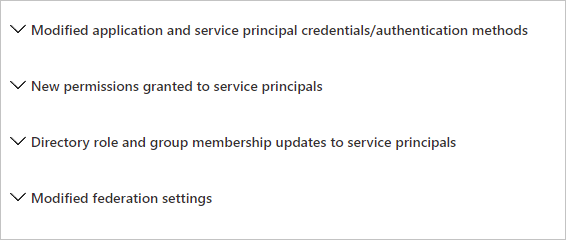Sensitive operations report workbook
The sensitive operations report workbook is intended to help identify suspicious application and service principal activity that might indicate compromises in your environment.
This article provides you with an overview of the Sensitive Operations Report workbook.
Prerequisites
To use Azure Workbooks for Microsoft Entra ID, you need:
- A Microsoft Entra tenant with a Premium P1 license
- A Log Analytics workspace and access to that workspace
- The appropriate roles for Azure Monitor and Microsoft Entra ID
Log Analytics workspace
You must create a Log Analytics workspace before you can use Microsoft Entra Workbooks. several factors determine access to Log Analytics workspaces. You need the right roles for the workspace and the resources sending the data.
For more information, see Manage access to Log Analytics workspaces.
Azure Monitor roles
Azure Monitor provides two built-in roles for viewing monitoring data and editing monitoring settings. Azure role-based access control (RBAC) also provides two Log Analytics built-in roles that grant similar access.
View:
- Monitoring Reader
- Log Analytics Reader
View and modify settings:
- Monitoring Contributor
- Log Analytics Contributor
Microsoft Entra roles
Read only access allows you to view Microsoft Entra ID log data inside a workbook, query data from Log Analytics, or read logs in the Microsoft Entra admin center. Update access adds the ability to create and edit diagnostic settings to send Microsoft Entra data to a Log Analytics workspace.
Read:
- Reports Reader
- Security Reader
- Global Reader
Update:
- Security Administrator
For more information on Microsoft Entra built-in roles, see Microsoft Entra built-in roles.
For more information on the Log Analytics RBAC roles, see Azure built-in roles.
Description

This workbook identifies recent sensitive operations performed in your tenant.
If your organization is new to Azure monitor workbooks, you need to integrate your Microsoft Entra sign-in and audit logs with Azure Monitor before accessing the workbook. This integration allows you to store, query, and visualize your logs using workbooks for up to two years. Only sign-in and audit events created after Azure Monitor integration are stored, so the workbook won't contain insights before that date. For more information, see Integrate Microsoft Entra logs with Azure Monitor.
How to access the workbook
Sign in to the Microsoft Entra admin center using the appropriate combination of roles.
Browse to Identity > Monitoring & health > Workbooks.
Select the Sensitive Operations Report workbook from the Troubleshoot section.
Sections
This workbook is split into four sections:

Modified application and service principal credentials/authentication methods - This report flags actors who recently changed many service principal credentials, and how many of each type of service principal credentials changed.
New permissions granted to service principals - This workbook also highlights recently granted OAuth 2.0 permissions to service principals.
Directory role and group membership updates for service principals
Modified federation settings - This report highlights when a user or application modifies federation settings on a domain. For example, it reports when a new Active Directory Federated Service (ADFS) TrustedRealm object, such as a signing certificate, is added to the domain. Modification to domain federation settings should be rare.
Modified application and service principal credentials/authentication methods
One of the most common ways for attackers to gain access in the environment is by adding new credentials to existing applications and service principals. The credentials allow the attacker to authenticate as the target application or service principal, granting them access to all resources to which it has permissions.
This section includes the following data to help you detect:
All new credentials added to apps and service principals, including the credential type
Top actors and the number of credentials modifications they performed
A timeline for all credential changes
New permissions granted to service principals
Attackers often attempt to add permissions to another service principal or application if they can't find a service principal or application with a high privilege set of permissions through which to gain access.
This section includes a breakdown of the AppOnly permissions grants to existing service principals. Admins should investigate any instances of excessive high permissions being granted, including, but not limited to, Exchange Online, and Microsoft Graph.
Directory role and group membership updates for service principals
Following the logic of the attacker adding new permissions to existing service principals and applications, another approach is adding them to existing directory roles or groups.
This section includes an overview of all changes made to service principal memberships and should be reviewed for any additions to high privilege roles and groups.
Modified federation settings
Another common approach to gain a long-term foothold in the environment is to:
- Modify the tenant’s federated domain trusts.
- Add another SAML IDP that the attacker controls as a trusted authentication source.
This section includes the following data:
Changes performed to existing domain federation trusts
Addition of new domains and trusts
Filters
This paragraph lists the supported filters for each section.
Modified Application and Service Principal Credentials/Authentication Methods
- Time range
- Operation name
- Credential
- Actor
- Exclude actor
New permissions granted to service principals
- Time range
- Client app
- Resource
Directory role and group membership updates to service principals
- Time range
- Operation
- Initiating user or app
Modified federation settings
- Time range
- Operation
- Initiating user or app
Best practices
Use modified application and service principal credentials to look out for credentials being added to service principals that aren't frequently used in your organization. Use the filters present in this section to further investigate any of the suspicious actors or service principals that were modified.
Use new permissions granted to service principals to look out for broad or excessive permissions being added to service principals by actors that might be compromised.
Use modified federation settings section to confirm that the added or modified target domain/URL is a legitimate admin behavior. Actions that modify or add domain federation trusts are rare and should be treated as high fidelity to be investigated as soon as possible.